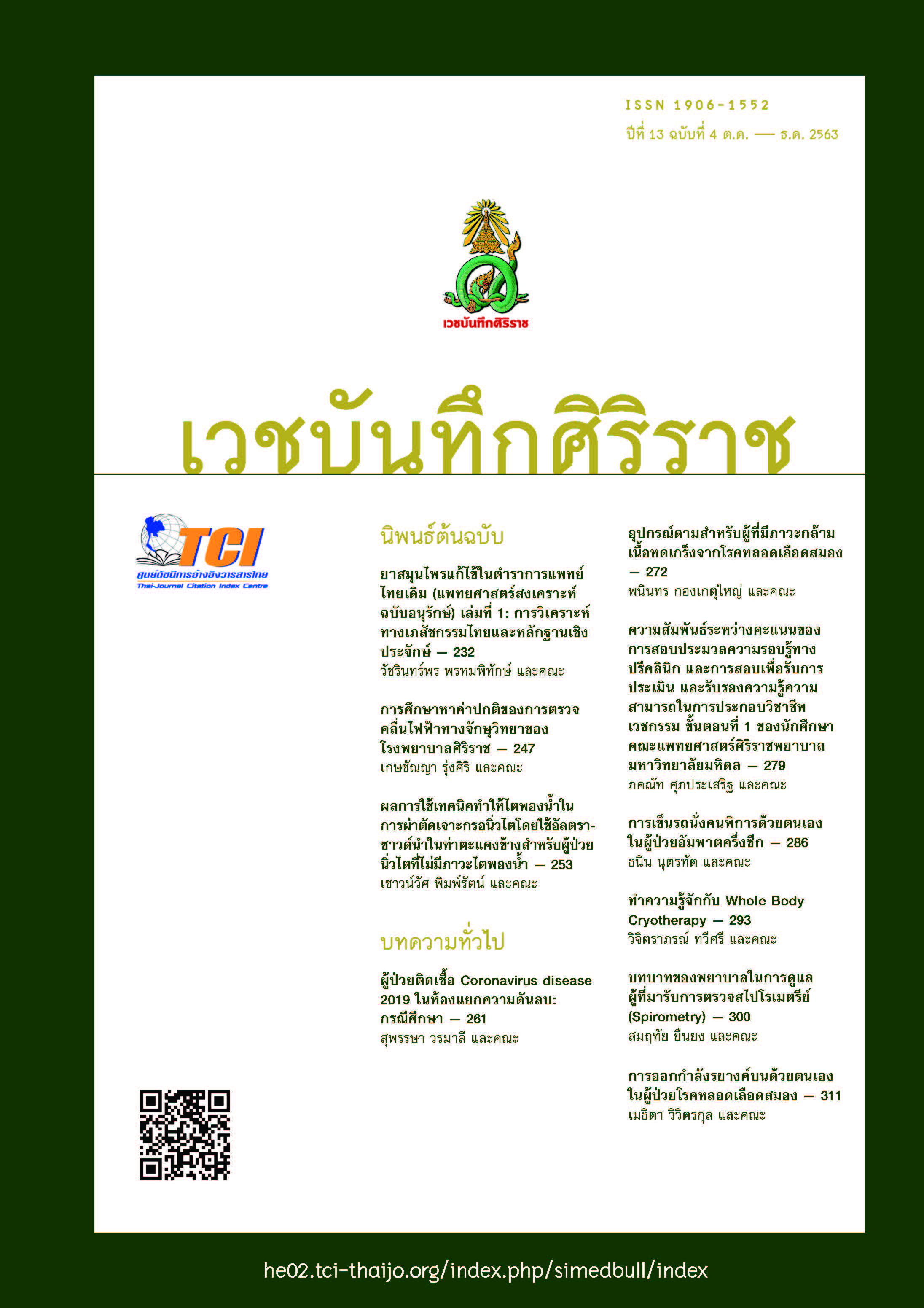Self ROM Exercise for Upper Extremity in Stroke
Main Article Content
Abstract
Stroke is a leading cause of death and disabilities in worldwide. Approximately sixty percents (62.5%) of stroke patients suffer from abilities and other complications. Common complications due to unable to move affected limbs are joint stiffness, muscle contracture, and edema of arm and hand. Those will disturb activities of daily living performance and cause low quality of life. The prevention of joint stiffness in upper limbs are to move an affected arm and hand correctly in every direction, called range of motion (ROM) exercise. The stroke patients can do active exercise by themselves. It will help the patient to improve self-esteem and decrease caregiver burden. Therefore, to educate self-ROM exercise of upper limbs is important and should be implemented in stroke rehabilitation program.
Article Details
References
2. กองโรคไม่ติดต่อ. กรมควบคุมโรค รณรงค์วันอัมพาตโลก ปี 2562 ให้ประชาชนรับรู้สัญญาณเตือนโรคหลอดเลือดสมอง ลดความเสี่ยงเป็นอัมพาต [อินเตอร์เน็ต]. นนทบุรี: สำนักสื่อสารความเสี่ยงฯ กรมควบคุมโรค; 2562 [เข้าถึงเมื่อ 7 เม.ย. 2563]. เข้าถึงได้จาก: https://pr.moph.go.th/?url=pr/detail/2/02/133619/
3. กองโรคไม่ติดต่อ. จำนวนและอัตราผู้ป่วยใน ปี 2559 - 2561 (ความดันโลหิตสูง, เบาหวาน, หลอดเลือดหัวใจ, หลอดเลือดสมอง, COPD) [อินเตอร์เน็ต]. นนทบุรี: สำนักสื่อสารความเสี่ยงฯ กรมควบคุมโรค; 2562 [เข้าถึงเมื่อ 8 พ.ค. 2563]. เข้าถึงได้จาก: http://www.thaincd.com/2016/mission/documents-detail.php?id=13684&tid=32&gid=1-020
4. Kim HJ, Lee Y, Sohng KY. Effects of bilateral passive range of motion exercise on the function of upper extremities and activities of daily living in patients with acute stroke. Journal of physical therapy science. 2014; 26(1): 149-56.
5. ทศพร บรรยมาก. กิจกรรมบำบัดในโรคหลอดเลือดสมอง. ใน: พิศักดิ์ ชินชัย, ทศพร บรรยมาก, ปิยะวัฒน์ ตรีวิทยา, บรรณาธิการ. กิจกรรมบำบัดสำหรับผู้มีปัญหาด้านระบบประสาท. พิมพ์ครั้งที่ 4. เชียงใหม่: สยามพิมพ์นานา; 2560. หน้า 177-188.
6. Malhotra S, Pandyan AD, Rosewilliam S, Roffe C, Hermens H. Spasticity and contractures at the wrist after stroke: time course of development and their association with functional recovery of the upper limb. Clinical rehabilitation. 2011 Feb; 25(2): 184-91.
7. Paci M, Nannetti L, Casavola D, Lombardi B. Differences in motor recovery between upper and lower limbs: does stroke subtype make the difference?. International Journal of Rehabilitation Research. 2016 Jun 1;39(2):185-7.
8. ปิยะภัทร เดชพระธรรม. การฟื้นฟูผู้ป่วยโรคหลอดเลือดสมอง. ใน: กุลภา ศรีสวัสดิ์, บรรณาธิการ. เวชศาสตร์ฟื้นฟูในปัญหาที่พบบ่อย. พิมพ์ครั้งที่ 1. กรุงเทพฯ: พี.เอ.ลีฟวิ่ง; 2561. หน้า 217-230.
9. นิพนธ์ พวงวรินทร์. โรคหลอดเลือดสมอง. พิมพ์ครั้งที่ 2. กรุงเทพฯ: เรือนแก้วการพิมพ์; 2544.
10. Hatem SM, Saussez G, della Faille M, Prist V, Zhang X, Dispa D, Bleyenheuft Y. Rehabilitation of motor function after stroke: a multiple systematic review focused on techniques to stimulate upper extremity recovery. Frontiers in human neuroscience. 2016 Sep 13; 10: 442.
11. Borschmann KN, Hayward KS. Recovery of upper limb function is greatest early after stroke but does continue to improve during the chronic phase: a two-year, observational study. Physiotherapy. 2020 Jun 1;107:216-23.
12. Pandyan AD, Cameron M, Powell J, Stott DJ, Granat MH. Contractures in the post-stroke wrist: a pilot study of its time course of development and its association with upper limb recovery. Clinical Rehabilitation. 2003 Feb; 17(1): 88-95.
13. Benlidayi IC, Basaran S. Hemiplegic shoulder pain: a common clinical consequence of stroke. Practical neurology. 2014 Apr 1; 14(2): 88-91.
14. Dawson A, Knox J, McClure A, Foley N, Teasell R. Stroke rehabilitation. Canadian best practice recommendations for stroke care. Heart and Stroke Foundation and the Canadian Stroke Network, Ottawa, Ontario Canada. 2013 Jul.


